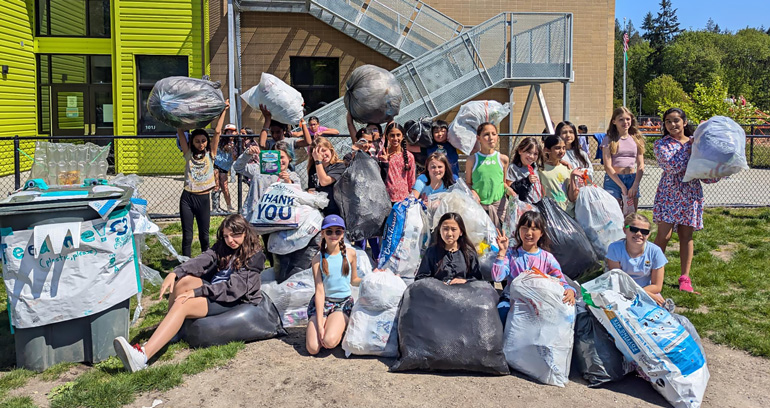Recycling collection benchmark
The recycling collection benchmark encourages schools and districts to create systems that increase recycling and reduce contamination. Increasing recycling can reduce disposal costs for schools and districts. It also ensures that valuable resources are kept in use and out of the landfill.
Criteria for recognition
Schools
- Show an increase in your recycling rate OR sustain a recycling rate of 40% for at least 3 months. Share your average recycling rate.
- Use this recycling rate worksheet to gather data and determine a recycling rate. Share your findings with the principal, custodian, and peers.
- Create a system to monitor contamination in recycling bins. Collect data over time (at least 2 weeks) to see how effective your system is. Share results with your program representative.
- Conduct a baseline Waste Walk Through (WWT) at least every 2 years. Use the information to set recycling and waste reduction goals.
- Share waste reduction goals with the rest of the school. Examples could include assemblies, newsletters, announcements, or social media posts.
- Place labeled and paired trash and recycling bins in all classrooms, offices, and common areas. Ensure the labels reflect current recycling guidelines. Refer to our recycling resources below for Green Schools Program examples.
- Share your recycling collection efforts and progress with your program representative.
Districts
Districts can find recognition criteria for the Recycling Collection Benchmark in the District Benchmark Guide.
Recognition form
Schools
Fill out the School Recycling Collection recognition form. Schools may fill out the form to receive the benchmark badge at any time of year.
You can complete the recognition form over multiple sessions using the "Save" button. You will be emailed a link that allows you to continue filling out the form. Once the form is complete, select the "Submit" button.
Check out all the schools that were recognized for Recycling collection in 2024-25.
Districts
Fill out the District Recycling Collection recognition form. Districts may fill out the form to receive the benchmark badge in the spring of each school year.
Recycling resources and activities
- Recycling rate calculation worksheet
- Determine the size of your dumpster worksheet
- Plan a paper recycling campaign
- Contact your Green Schools Representative to order signs, stickers, or bins
Interested in learning more? Check out our resource list for more detailed information on this benchmark topic.
Success stories
At Park Orchard Elementary School in Kent School District, custodian Peter Loke helped older Green Team members mentor younger students about how to recycle. He also made announcements every day during lunch about what could go in the recycling and what could not. As a result, Park Orchard Elementary reduced their garbage capacity from an 8-yard dumpster emptied twice weekly to a 6-yard dumpster emptied once weekly. A similar story occurred at Kent Elementary School. After educating students about proper sorting and monitoring, the school was able to reduce the frequency of their garbage collection from two times to one time per week.
Students at Margaret Mead Elementary in Lake Washington devoted their Green Team efforts to multiple recycling projects this year. They collected over 286 gallons of plastic film waste and sent it to Ridwell to be recycled. They also made sure that every classroom had a G.O.O.S (Good On One Side) paper bin. Finally, the Green Team made sure that when they made posters or other educational materials, they used recycled paper or re-purposed poster board.

 Translate
Translate